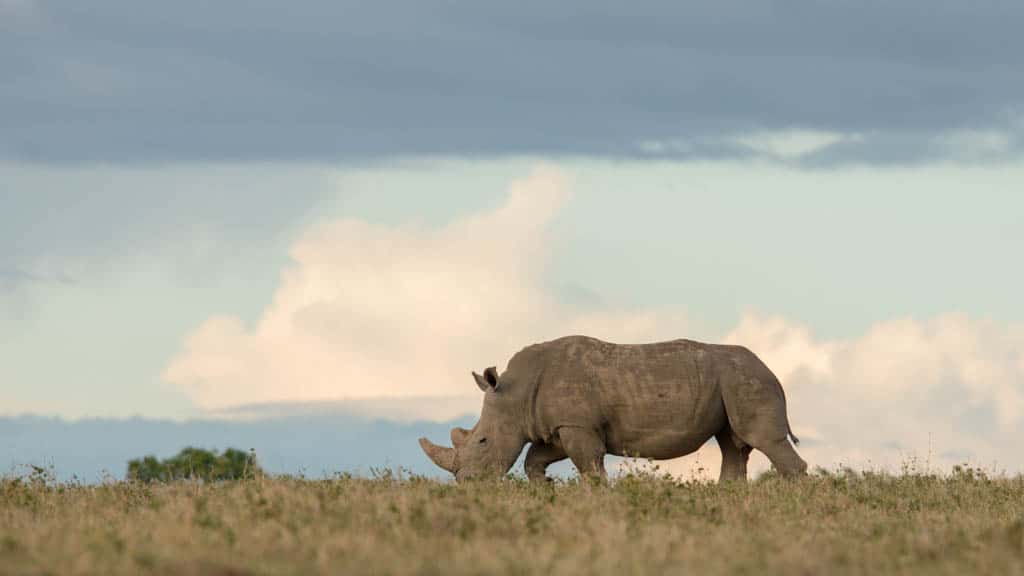Snow Ghost: Photographing the Snowy Owl
As winter rolls along, I am wondering what is in store for my work as I hunker-down at home in Montreal. I have not ventured out with my camera in months! The winter of 2019-20 was memorable as it was the year I met my first snowy owl! While this truly magnificent owl is the official bird of my home province of Québec, I had never actually seen one in the wild. Last winter changed all that.

These large owls migrate down from the Artic during the winter months and can be found in areas with open fields–their preferred hunting grounds. They like to perch on the ground or on low fenceposts where they will patiently wait for their prey, usually a small rodent. Have you ever tried looking for something white, in a field of white? It can be a challenge!
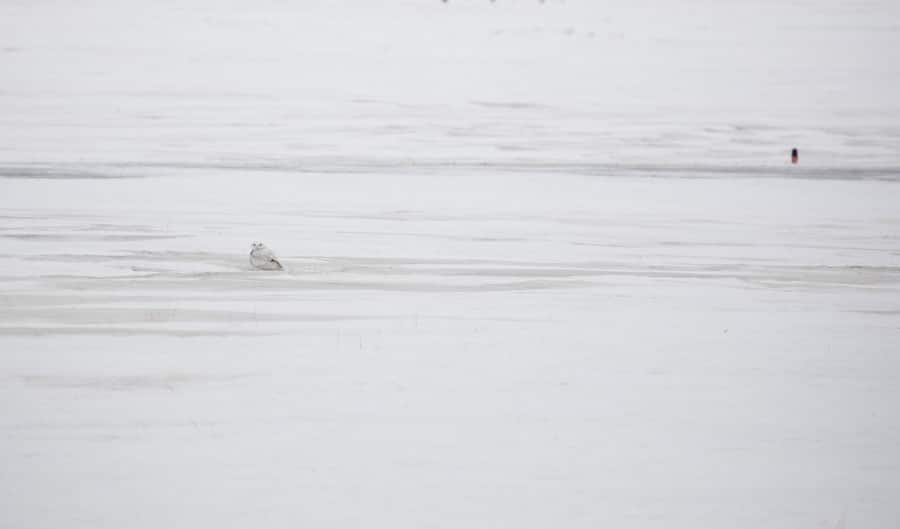
Snowy on a Snow Bank
Luckily, I was able to spot a couple of snowy owls for some closer encounters. However, the fellow I spent time with insisted on hunkering down between two very dirty snowbanks, making for a very unattractive photo shoot. Still, it was a thrill to see one of these birds up close.
On my return visit the sides were overcast and I found him in the same area, once again sitting up on a dirty pile of snow. I decided to try something a little different...
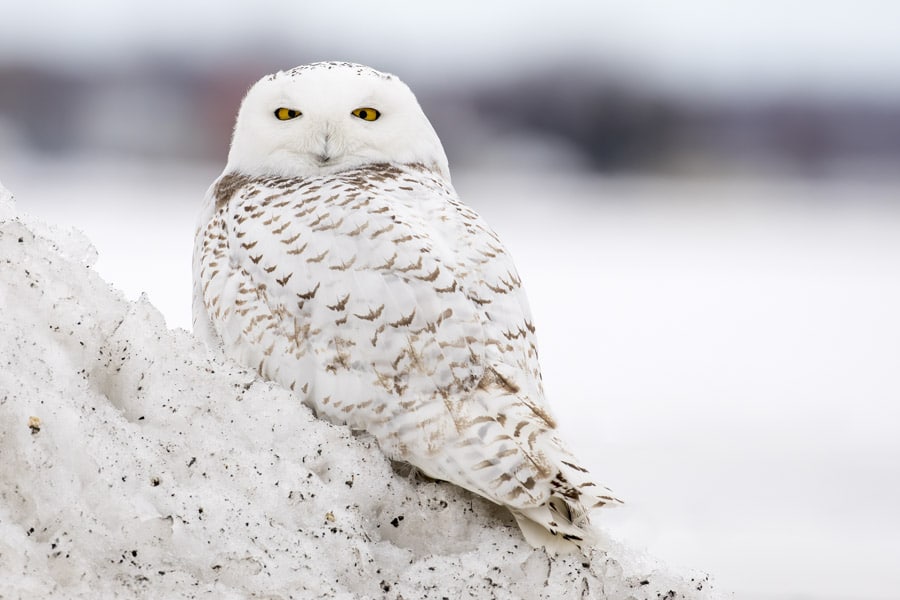
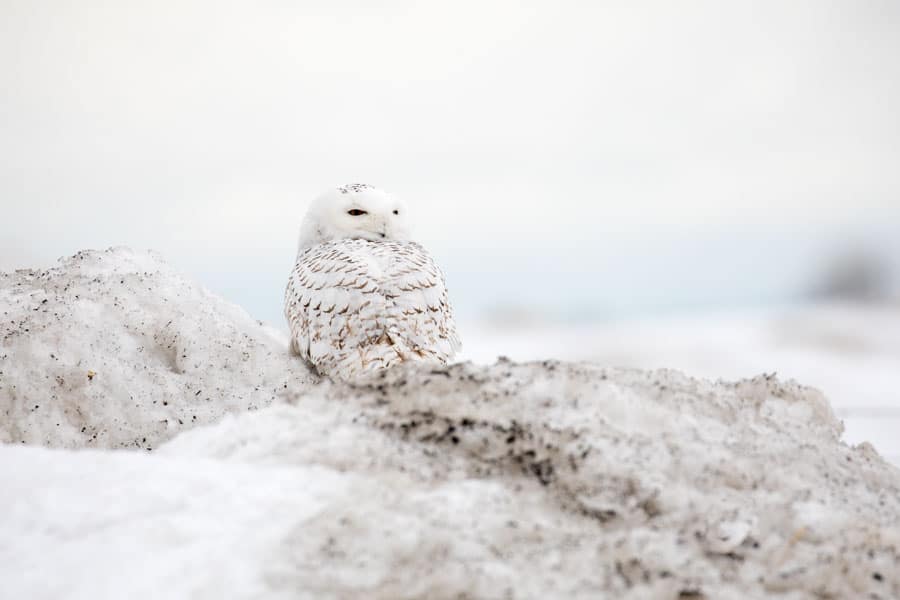
Ghostly Snowy Owl
I wanted to create an image that evoked more of an ethereal feel of this exceptional creature, having him appear almost ghost-like. I dug a trench in the snow and got down on my belly, burying my lens and pushing snow away from part of the lens opening. I really wish I had thought to tuck my shirt in before I did this–I can assure you that snow on the belly can motivate you to work quickly! The owl was very co-operative sitting in one place, surveying his kingdom although I am pretty sure I saw him roll his eyes at my antics.


Hopefully I be lucky this winter and have another chance to photograph one of these magnificent owls that live here in our backyard in Québec.
One more thing...
Thank you very much for visiting my blog. I support myself as an artist with my photography and writing. If you enjoy my content and would like more, please consider supporting me on KO-FI.COM Becoming a member of the Armchair Wanderers or one of The Wild Bunch will give you access to exclusive member only content-including behind-the-scene safari updates from my travels. Thank you for your ongoing encouragement and promoting my passion.
Visit the Oh Canada! GalleryWorld Rhinoceros Day 2020
A mountainous marvel of animal engineering, the rhinoceros is like no other. Leathery and lined, massive and muscled, his noble horn a cautionary prelude to a quiet, determined stare. The rhino is at once, a prehistoric relic and a 21st century icon.
Rhinoceros Poaching Statistics
I cannot imagine a world without rhinoceros. In South Africa, where approximately 80% of the world rhino population lives, rhino poaching continues at a rate of almost two a day. While the numbers are finally on the decline, there are still far too many killings. (http://www.savetherhino.org)
Rhinoceros I Have Known
 In the past 13 years I have encountered wild-living Rhinosceritidae more than 20 times in three countries. Each and every time I have wondered if it would be my last encounter. As a visual storyteller, my goal is to make connections with the sentient beings around us to invoke a passionate awakening in the soul. I push myself to make images that inspire imagination where, in a single moment, the heart might connect with the mind and lead one to think and act in new ways–ways that could end the senseless killing of the earth’s wildlife. The senseless killing of the rhinoceros
In the past 13 years I have encountered wild-living Rhinosceritidae more than 20 times in three countries. Each and every time I have wondered if it would be my last encounter. As a visual storyteller, my goal is to make connections with the sentient beings around us to invoke a passionate awakening in the soul. I push myself to make images that inspire imagination where, in a single moment, the heart might connect with the mind and lead one to think and act in new ways–ways that could end the senseless killing of the earth’s wildlife. The senseless killing of the rhinoceros
Until we truly understand and embrace that we are all connected, we will continue to lose species with no clear understanding of the consequences. So, on this World Rhino Day 2020, I fondly look back and speak to you through the very first rhinoceros I ever photographed. From these very first sightings, years before wildlife photography would become my calling, I was entranced by these massive animals with their magnificent facial ornaments and dinosaur-like bodies. I hope they might spark your imagination and stir your sense of wonder. These images capture but a moment of their glorious story, a centuries-old tale that seems destined for a tragic ending unless we stop the senseless slaughter.
You Never Forget Your First Rhinoceros
I was introduced to my very first black rhinos in the Phinda, South Africa in 2008. Being chased by storms and heading back towards camp, our ranger suddenly throttled the Land Rover over the ditch. He headed off-road, bouncing us straight towards the blackening skies and…two black rhinos! We followed at a safe distance as they grazed towards the hillside. For a brief moment the sun broke through the ominous clouds, spilling a brilliant rainbow behind them. This was truly an African pot of gold. They turned towards us, halting our progress, allowing me to quickly capture one of my very first rhino photos I call Pair of Blacks. (Or, for those of you with loftier imaginations, The Two-headed Rhino.)
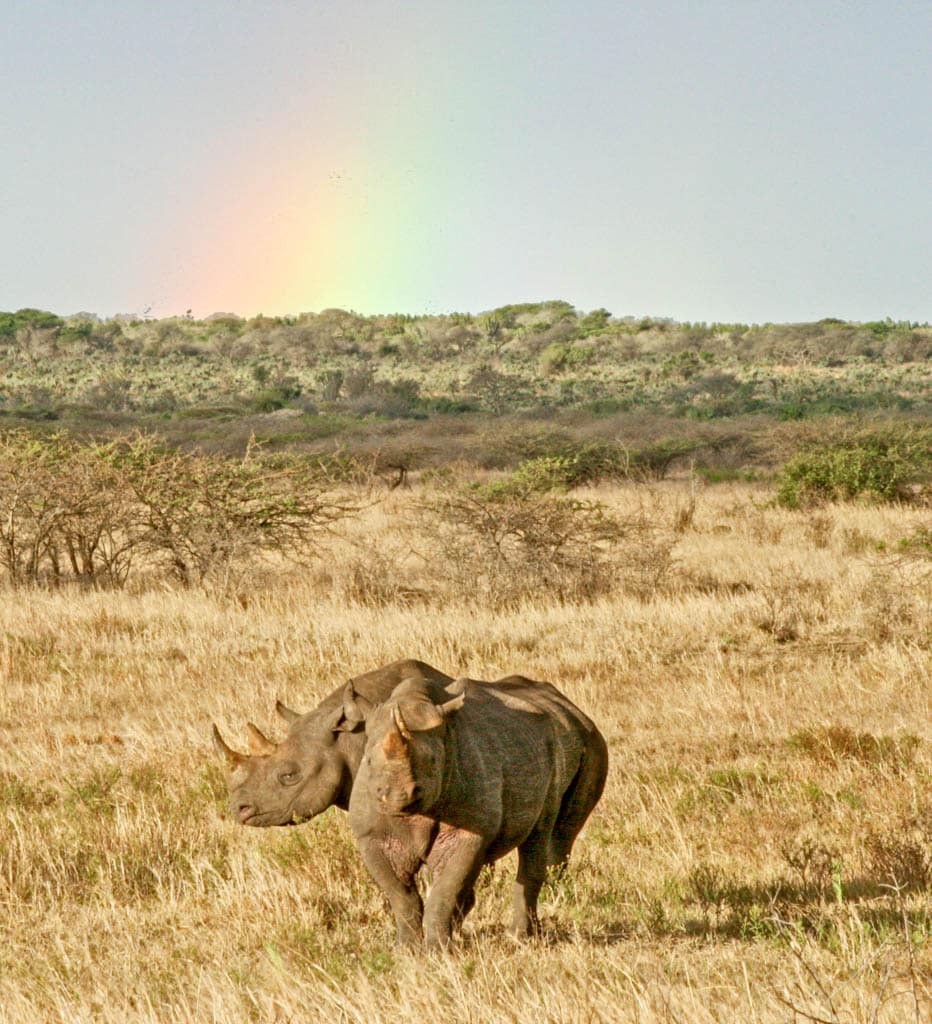
The black rhino has a hooked lip and is slightly smaller than this relative the white rhino. They are browsers and the hooked lip allows them to pull leaves off trees and bushes to supplement their diet of grass.
A Rhino Encounter of a Special Kind
The following day would bring a rhinoceros encounter of a very close kind! Coming up on four grazing white rhinos on the roadside, we pulled over to enjoy their company. They were relaxed and intent on grazing. Unlike the black rhino with its hooked lip, the white rhino has a squared-off lip and relies on grazing.

I was sitting up on the back bench the truck, my boot propped up on the open side, when a very calm and massive male began wandering towards me. Coming closer, eyes on mine, his impressive horn dipped well into the minimum focus distance of my 70-300 F4-5.6. He stood still, then sniffed my boot. Seemingly satisfied with my hygiene he slowly backed away and returned to the tall grass on the side of the ditch. It’s a wonder I had the presence of mind to hit the shutter. While the image is somewhat soft, it serves me well to bring back the vivid memory of this magical encounter.
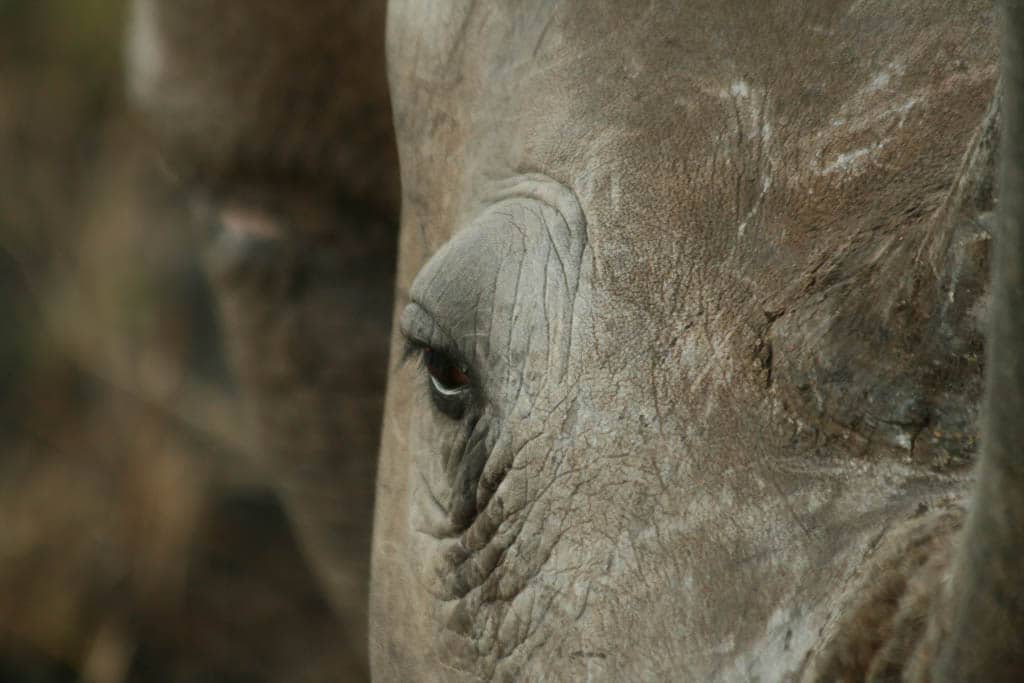
A Wildlife Icon
The rhinoceros is the second largest land mammal in the world–it is a symbol of our wild planet–and it is disappearing at an alarming rate. Of the 5 species of rhinos left on the planet, 3 are now critically endangered, while 2 are vulnerable to extinction. While habitat loss threatens so many of the planets species, the rhinos biggest threat is poaching. Rhino horn is in high demand in the thriving black market in the illegal trade in animal parts. Rhino horn is currently selling for upwards of $50,000 a kilo on the thriving black market in animal parts. We are decimating one of the worlds iconic species to use in mythical potions. Horn is not medicine and we must stop the senseless killing. Education and awareness is vital if we are to secure a future where these extraordinary animals continue to share our planet.
One more thing...
Thank you very much for visiting my blog. I support myself as an artist with my photography and writing. If you enjoy my content and would like more, please consider supporting me on KO-FI.COM Becoming a member of the Armchair Wanderers or one of The Wild Bunch will give you access to exclusive member only content-including behind-the-scene safari updates from my travels. Thank you for your ongoing encouragement and promoting my passion.
The Rhinoceros Gallery Visit the Rhino CemeteryDad-jay: Remembering my Father
My Dad would have turned 89 this week. He passed away two years ago, a few days after his 87th birthday. This is the story of Dad-jay, a blue jay who came to see me when my Dad passed, and who continues to keep me company today. Some of you may have read parts of this story before, some of you may be reading it for the first time, but either way, I hope you find some solace and joy in this true tale of how nature holds a place in our hearts.
My Dad’s name was John and he was a first generation Scottish Canadian. He had beautiful blue eyes, a great sense of humour and could cut a mean jitterbug! He passed away in September of 2018 after a struggle with Alzheimer’s. A couple of days after he died, I woke up with vivid thoughts of my Dad. I got up, made my coffee and looked out on the back deck. There was a gorgeous blue jay sitting looking back at me.
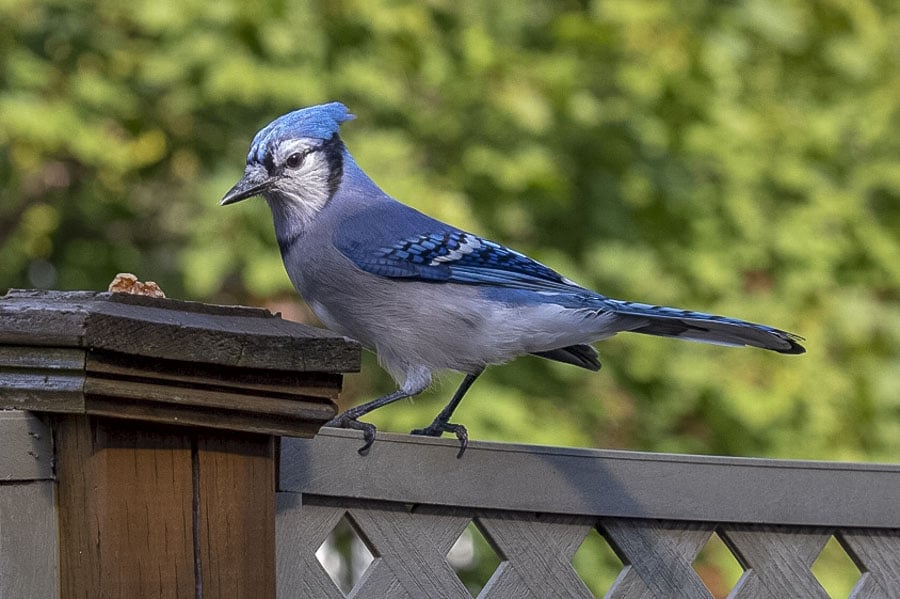
In 14 years blue jays have NEVER come near my deck. In fact, in all my years photographing birds, as soon as I would spot a jay on any of my hikes, they would disappear before I could raise my lens. But this guy was sitting right out on the deck, just feet from the back door. I grabbed some nuts from the pantry and opened the door, expecting him to fly off, but he stayed right where he was. I took a few steps towards him and left the nuts on the rail beside him. Before I could step back inside, he hopped over next to me and picked up a couple of snacks. It was utterly bizarre and beautiful!
My Dad had stopped eating towards the end of his life. The blue jay must have eaten and cached over 30 nuts that morning and all I could think of was that my Dad was ok. He was letting me know he was eating again.
My Companion in Sorrow
In the weeks that followed, Dad-jay continued to visit me every day or other day, while I mourned my Dad. I was in the middle of a kitchen renovation and the workmen could not believe it. Dad-jay look in the window for me, the workmen would call me and I would go out with some nuts. They would all stop and watch and take pictures! He was also fine with Pluto visiting, and she was quite curious about this special visitor getting snacks!
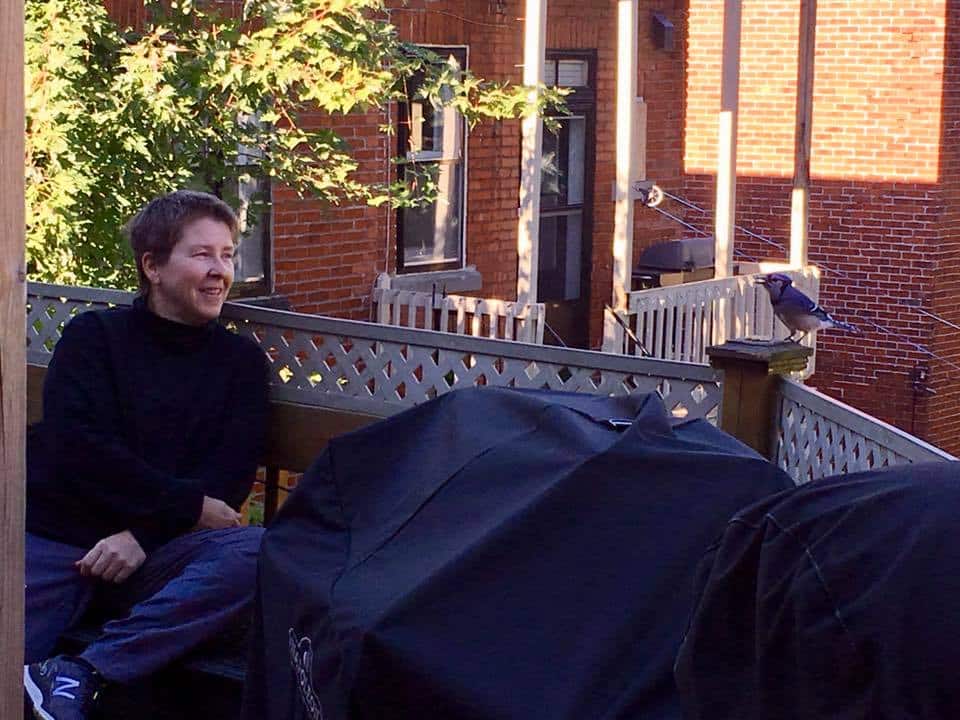
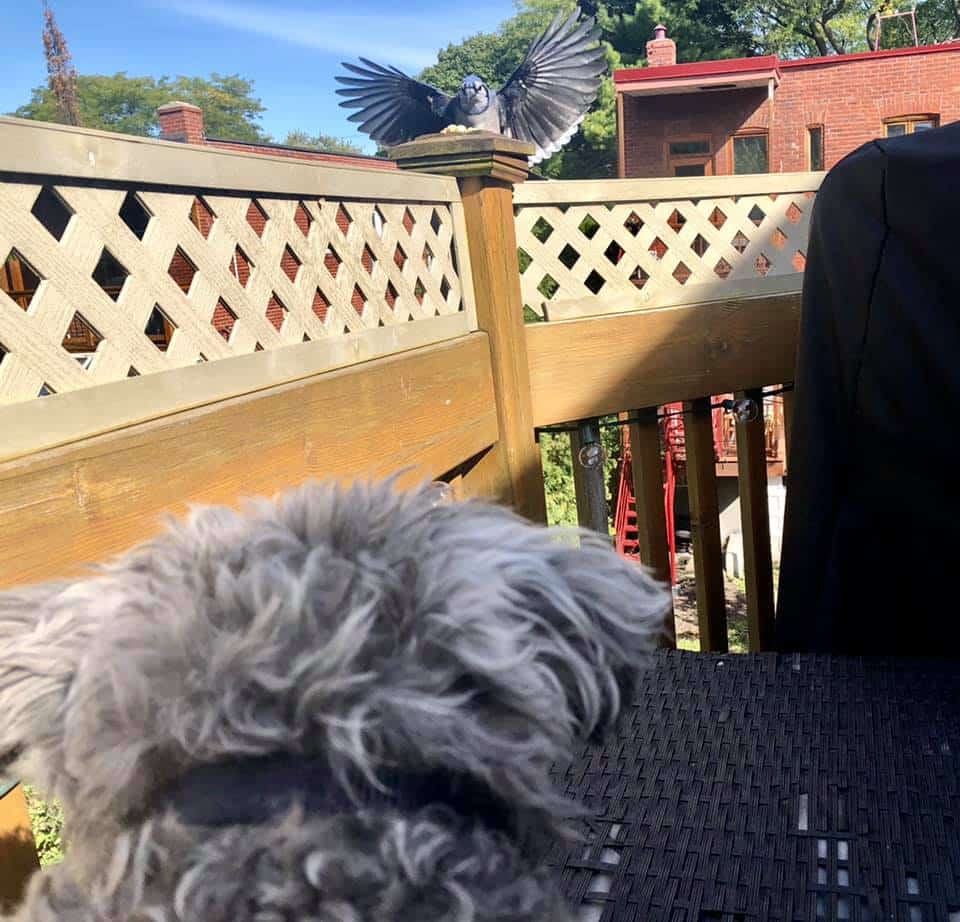
One day I was out on the front porch and he came to the wires above, called incessantly to get my attention. Once I looked up, he flew back and sat in the dining room window at the other end of the house. He sat there watching me as I came down the hall to get his nuts. He started bringing his lady-jay friend and although she was a little more timid, she enjoyed the nuts as well
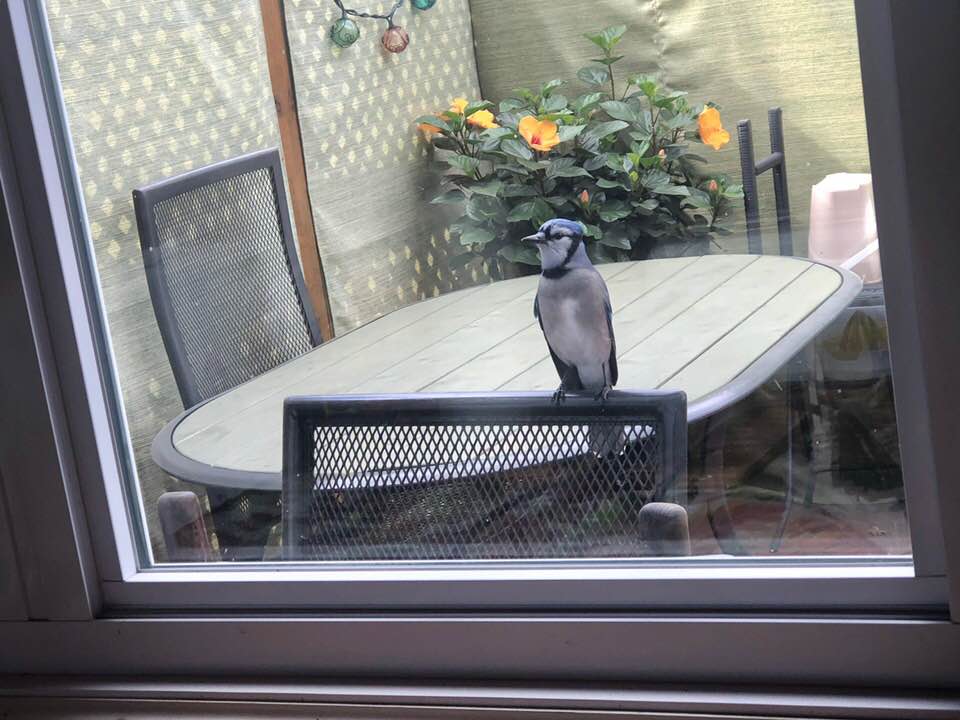
Dad-jay's Final Good-bye
A few weeks later, on the day we would lay my Dad to rest, he came to see me in the morning. I was making Rice Krispy squares–my Dad ate RK’s every morning of his adult life. We had a nice visit and I sat next to him and shared some peanuts. The following day at the reception, I dropped everyone at the door and went to park the car. When I got out of the car, a blue jay called from the trees. At the time, I thought it was his final goodbye, but I would be wrong.
Several months later, I had to undergo surgery. When I woke that morning, he was back! I loaded the rail with peanuts and he took them one by one, caching them around the hood. When a second death struck the family a couple of months later, Dad-jay arrived and stayed a couple of days, offering some mysterious reassurance that all was well in the afterlife.

A year passed and on the anniversary of my Dad’s death, this remarkable bird was in the kitchen window waiting for me, helping me get through that particularly tough day. His girlfriend, now a little less nervous, and a smaller juvenile joined him.
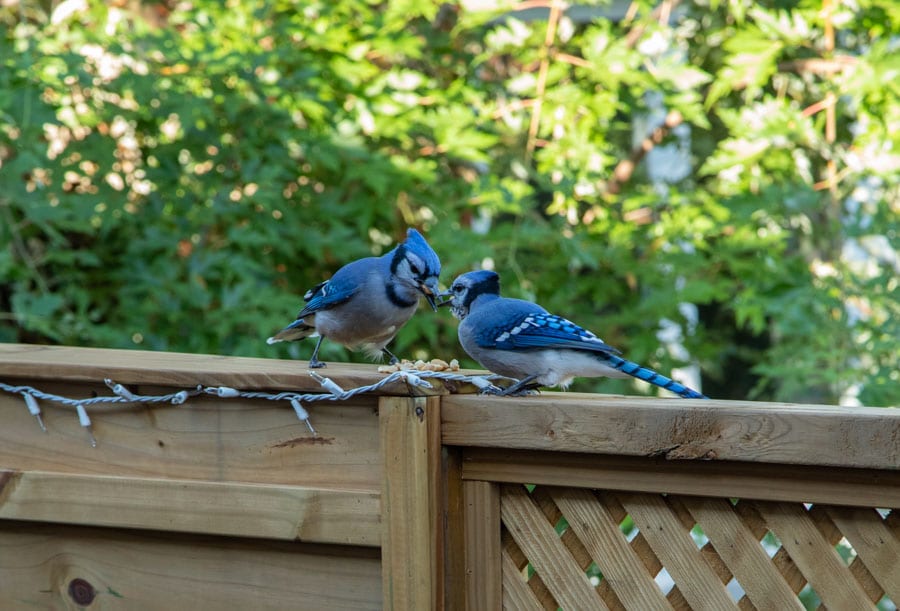
Another Anniversary and Dad-jay Returns
For two years Dad-jay has stopped by at just the right moments in time. I am often asked how I know it is the same blue jay? I just do. He comes to the same window, perches in the same spot and spends time next to me. For me, there is no doubt.
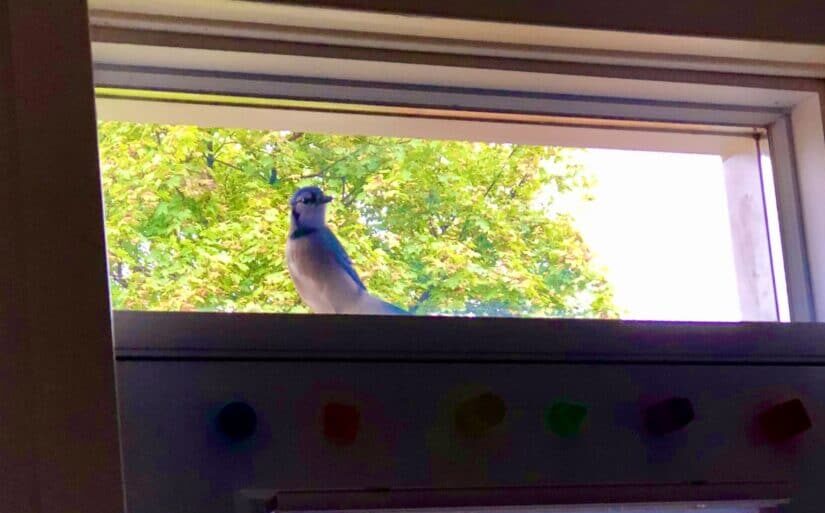
Last week, as the anniversary of my Dad’s death approached, he showed once again–in full moult! This time there was another pair with him and I feel strongly they are his family. They are timid, swooping in to pick up a nut and then quickly flying off. But not him. He still sits in the window or will hop over and stand right next to me as he chooses his peanut. He actually picks them up and shakes them, choosing to fly off with what I believe is the heaviest one!
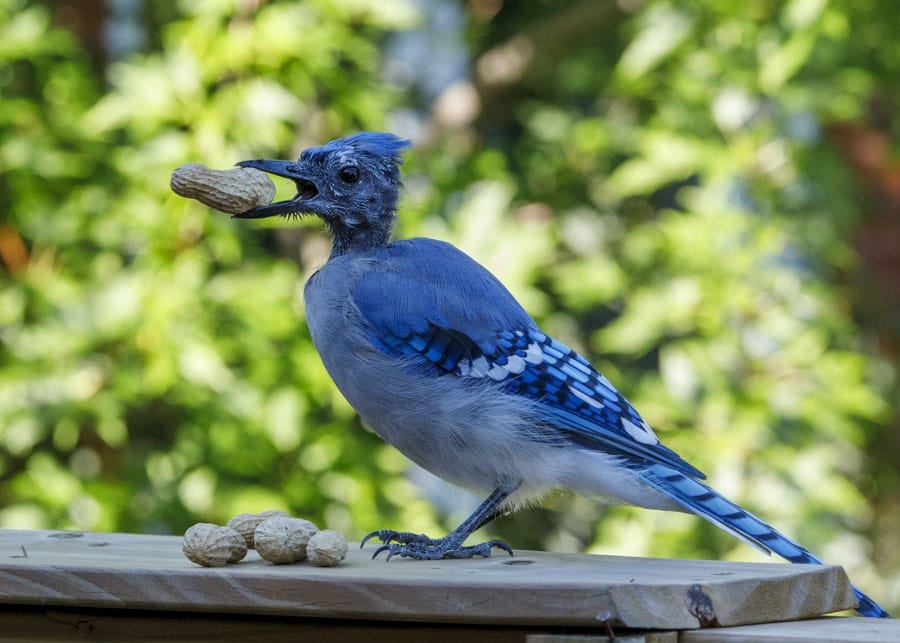
I am delighted and reassured he continues to visit. Knocking on the window or calling until I show up, he stays patient by the backdoor. I continue to thank him for his company. I no longer question the wonder of it all.
Miss you Dad.
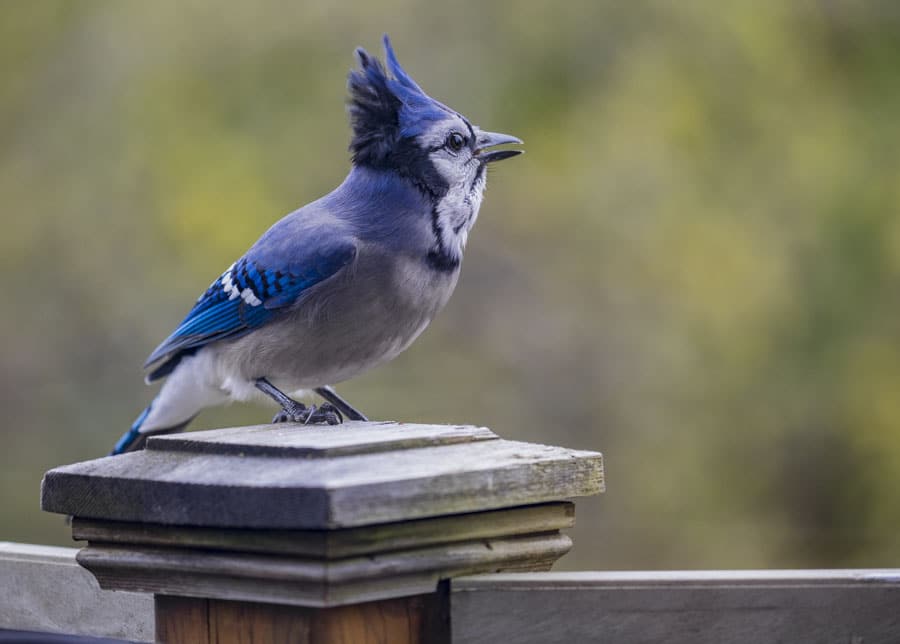
Thanks for supporting my work!
If you enjoy my content, please visit my ko-fi pages and consider becoming a member of the Armchair Wanderers or the Wild Bunch! Ko-fi members have access to exclusive images, videos and stories not posted anywhere else–including behind-the-scenes safari antics while I am on location shooting in Kenya! Membership has its privileges!
African Birds Gallery
Getting Serious About Wildlife Crime
Black Market Wildlife Crime
It's time to get serious about wildlife crime.
Some nights I lie awake remembering the moments I have spent in the company of Africa's extraordinary wildlife. My mind drifts to a darker place and I can't help wonder if the animals I have photographed are still alive? I wonder if they are hunting, grazing, mating, playing, fighting. Being. I lie awake wishing it was all a very bad dream...
Elephants, lions, rhinoceros, vultures, apes, wild dogs...the list goes on. They are disappearing under our watch, slaughtered for body parts to be carved into fashion accessories or sipped in magic elixirs. They are being hunted for their meat and traded for money, trapped and sold for our entertainment and amusement. Black market animal trafficking is now estimated at a staggering 7-9 BILLION dollars, not far behind drugs, weapons and human trafficking.
Sadly, the numbers do not lie. Killing animals is BIG business and we need to get serious about wildlife crime.
Elephants
Africa has lost 99% of its elephant population since the 1930's. There were approximately 10 million elephants in the 1930's and the African Wildlife Foundation now estimates the population closer to 470,000 individuals. While the elephant numbers dwindle, the price of ivory in China does anything but. Since 2010 the price of ivory has increased as much as tenfold.

Lions
Around the time I was born, there were an estimated 100,000 lions roaming in Africa. There are approximately 20,000 remaining. The decline is staggering. The death of one mature male lion can have significant impact on a local population. (See The Sad Story of Lion Math) I cannot imagine a world without lions, and yet, it may happen in my lifetime.
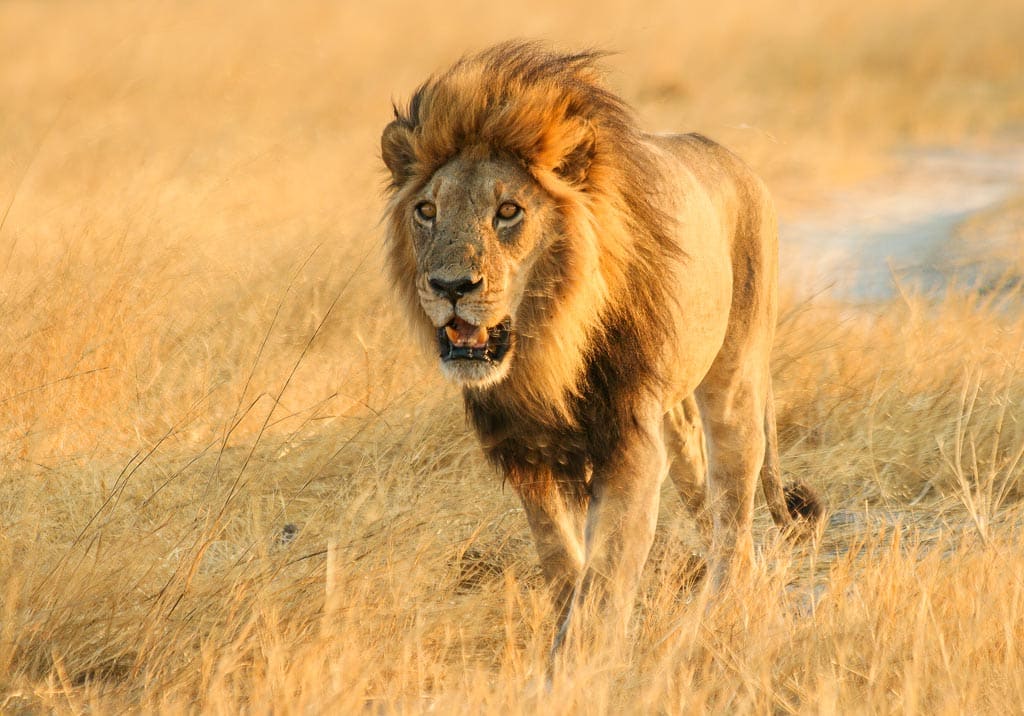
Rhinoceros
I have been lucky to photograph both the black and white rhinoceros at a time when it is facing the most intense threat of all African wildlife. Rhino horn is more valuable on the black market than cocaine and diamonds. At $60,000 kilo, it is by far the most valuable commodity in illicit wildlife trafficking business. In South Africa the penalty for trafficking in small amounts of cocaine starts at 5 years in prison. For rhino poaching the fine is a very affordable $14k. While overall poaching numbers for rhino in Africa have declined over the past few years, the numbers are still a serious threat to the population. There were 750 slaughtered rhinos reported in 2019. According to savetherhino.org, between 2010 and 2019 there were 9441 recorded killings–that is 3 rhinos poached every day.
1 every 8 hours…

Wild Dog
The African wild dog is considered one of the most endagered animals in the world. A pack of dogs will traverse a range as big as 900 square miles. These nomadic pack animals are living on diminishing land parcels areas as human population take over more space. This has resulted in hunting challenges and inevitably, deadly conflict with farmers and herders. The reduced roaming area has led to a weakened gene pool for reproduction. Closer contact with domestic animals has introduced rabies and distemper into the wild dog population, killing large numbers of dogs.
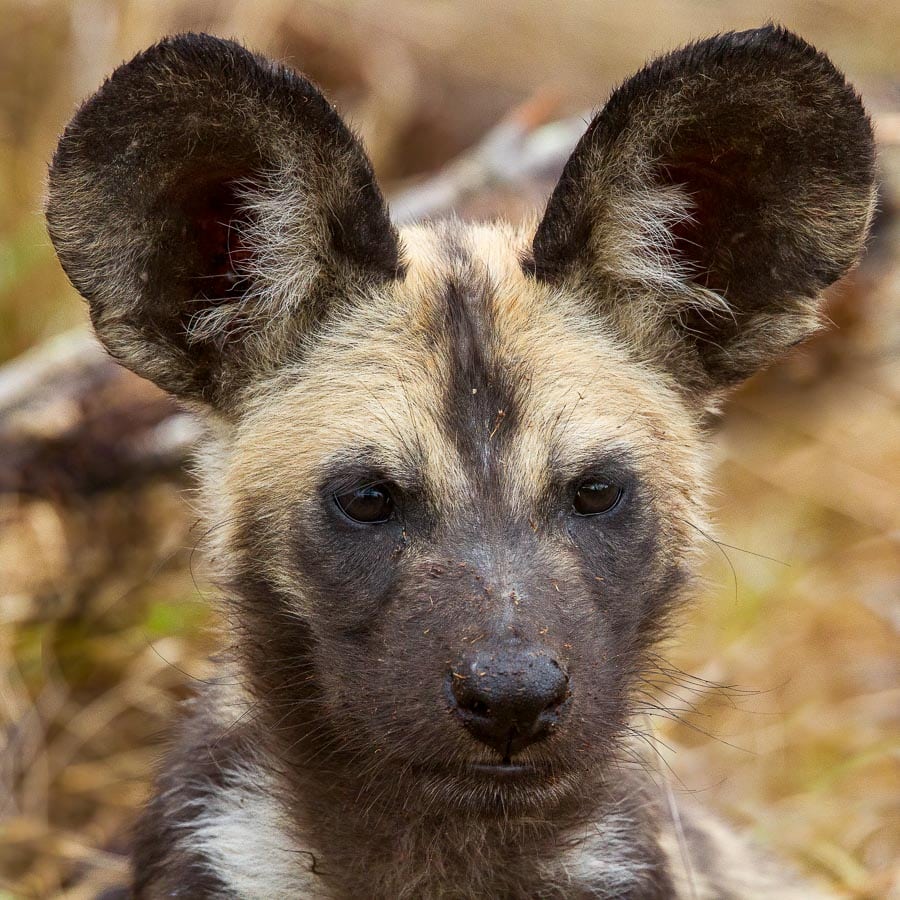
Serious About Wildlife Crime: Humans
"Education is the most powerful weapon we can use to change the world." ‑Nelson Mandella
It is really is up to all of us...
View Lion Gallery
The Rhinos of Ol' Pejeta: Rest in Peace
Ol' Pejeta Conservancy has a deep history of rhino conservation and is home to Kenya's largest population of Black Rhinos. There are currently over 100 living on these protected lands. Critically endangered, the black rhino population plummeted over 90% from 1960s through the 1990s — poached almost out of existence. By the mid-nineties there were an estimated 2300 left alive. Today, there are estimated to be between 5,000–5,400 black rhinos left in Africa, with about 110 in Ol' Pejeta. Sadly, strong demand for their horn continues to threaten their survival.

White Rhinos on Ol' Pejeta
There is also a growing population of Southern White Rhinos on the conservancy. White rhinos were near extinction at the end of the 19th century, with less than 50 individuals remaining in South Africa. Through tremendous conservation efforts, the population is now over 20,000 across east and southern Africa. Ol' Pejeta is home to 30. We were very fortunate on this trip to see 5 different white rhinos, including a young calf grazing with both parents.
Rest in Peace Sudan
The conservancy was also home to Sudan, the last male northern white rhino who became known around the world and who died on March 20, 2018. Extinct in the wild, Sudan was one of 4 of the world's last 7 northern white rhinos that came to live in Ol' Pejeta in September 2009, arriving from a zoo in the Chezch Republic. Now, only two females remain and the conservancy vets, along with the zoo, are trying to develop a technique for in vitro fertilization–something that has not been previously done with rhinos. (You can read about the efforts here.)
The Rhino Cemetery
During my last visit in 2018, on a grey and rainy afternoon, I visited the rhino cemetery to pay my respects to the rhinos who rest there. I had not visited this sacred place on previous trips to the conservancy and it was quite an emotionaly charged experience. Fifteen graves are marked with headstones and bronze plaques, paying tribute to the lost lives of these threatened animals.
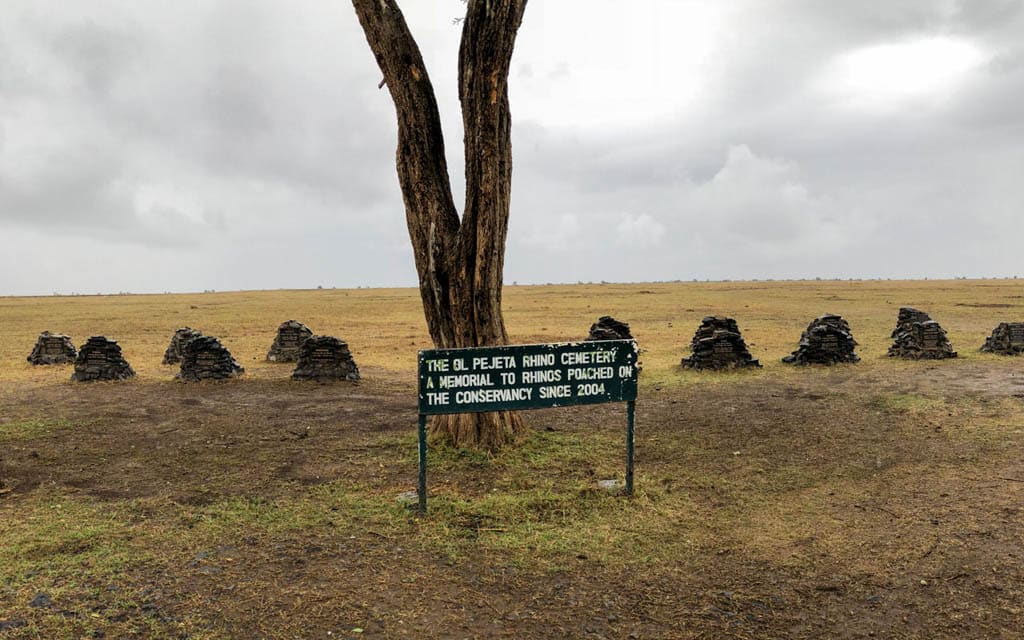
Amongst the group is the resting place of Ishirini, a female black rhino who, in 2016, was killed at the age of 20. She was 12 months pregnant when she was found writhing in pain, horns cut off. She did not survive.

The rhinos that rest here range in age and include both males and females. Many were found shot dead, horns removed. Max, age 6, was slaughtered even though he underwent dehorning procedures meant to protect him from poaching. He was found dead with his very small, regrown horns cut off.
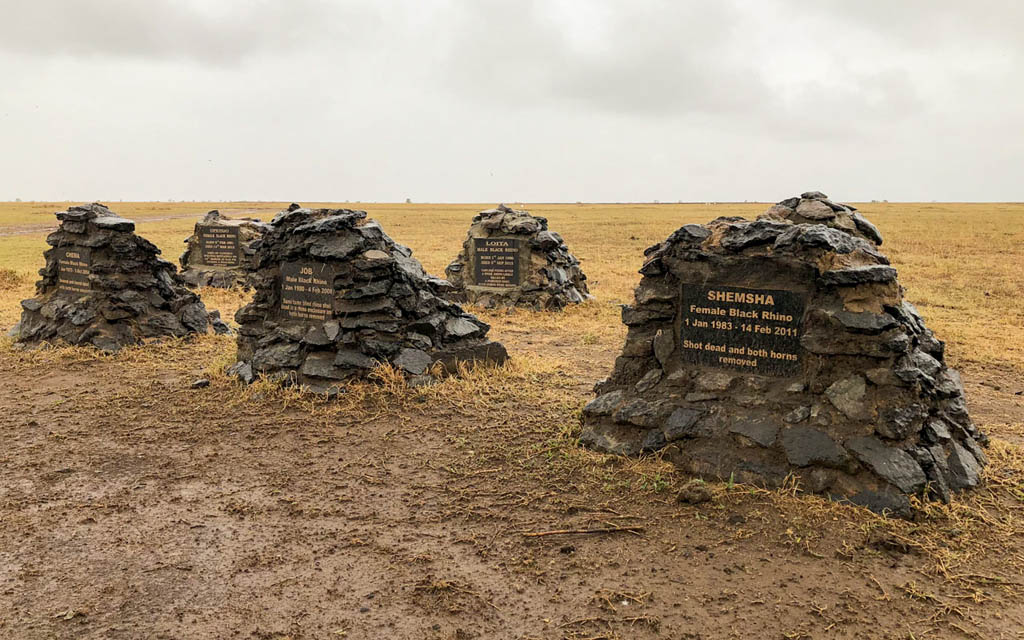
Horn is Not Medicine
The graves of these magnificent and peaceful animals serve as a painful reminder of the need to continue to fight against poaching and trafficking in animal parts. Rhino is readily available on the black market and sells for $60k a kilo. It remains in high demand, especially from Vietnam. Conservation efforts continue, but so does the investment in poaching for black market profits. If it doesn't stop soon, we risk losing Africa's two remaining rhino species.
Rhino horn is not medicine. Rhino horn is not an aphrodisiac. It is keratin — just like our finger nails. It belongs no where but on a rhino.
The Texture of Elephants: Living Landscapes in Nature
When I dream of Africa, I dream of elephants...

The Texture of Elephants
Wrinkled and rough, creased and crusted, the texture of elephants create living landscapes in nature. These thundering giants with gentle eyes captivate and hold tight in our imagination. Even if you have never seen one, it is likely that your mind can quite easily conjure up an image of this unique and curious creature. And yet, if you have been lucky enough to encounter one up close, you might be hard-pressed to find the words to describe it the magic of being in its presence.
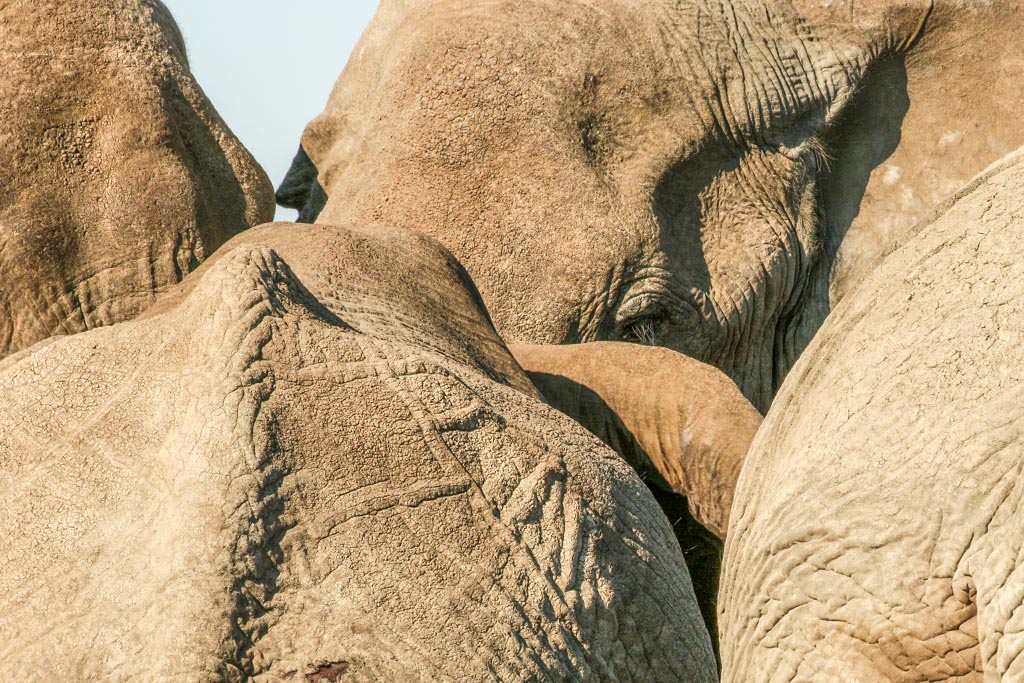
Wild Elephant Encounters
Whether sitting quietly surrounded by a large herd in the Sabi Sands, listening to the cracking of branches and swooshing of trunks as they forage and feed in the woodland, or watching a family play and relax on the banks of Kenya's Ewaso Ngíro River, each experience has been different from the last. And each encounter leaves me longing for the next.
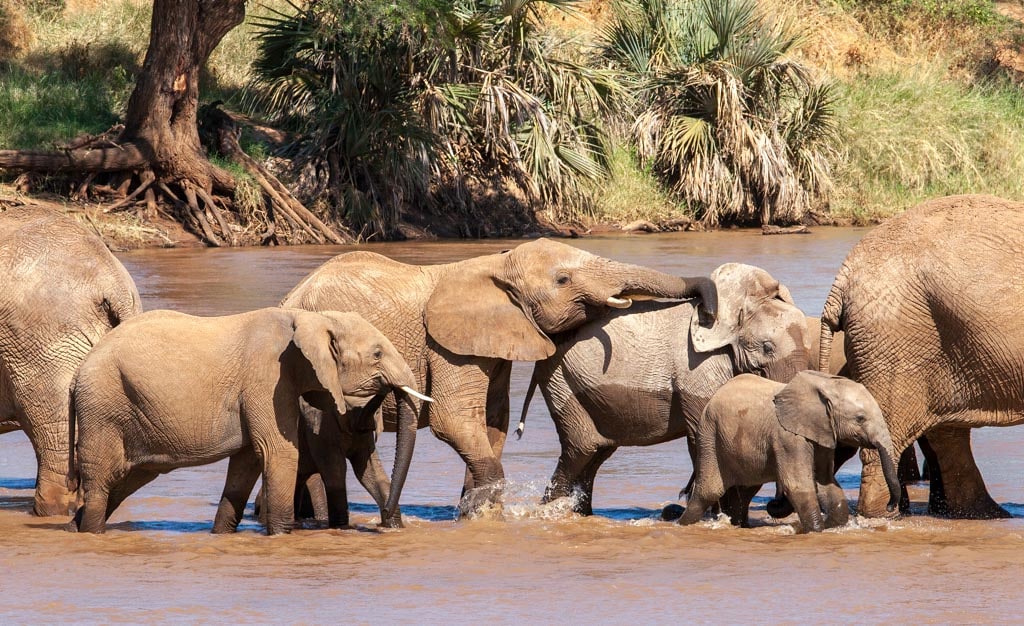
Love at First Sight
My very first trip to the continent was visiting Tanzania in 2007 and I was rightfully humbled by the mock-charge of a large bull in musth! It was in Tanzania that I first stood barefoot in elephant footprints and watched in the moonlight as a small family crossed a dry riverbed 100 feet from our truck. There years later, in Kenya's Samburu National Reserve, I photographed a 3-day old calf — and the next day, that same calf taking baby steps, another day older.
Once, at first-light in Botswana's Okavango Delta, a young bull paid me a visit at my tent, his eyelashes poking through the mesh window as I was lacing my boots. Every experience has been memorable. You do not easily forget an elephant encounter. Now, after 10 years of travelling to Africa, my elephant memories will last me a lifetime!
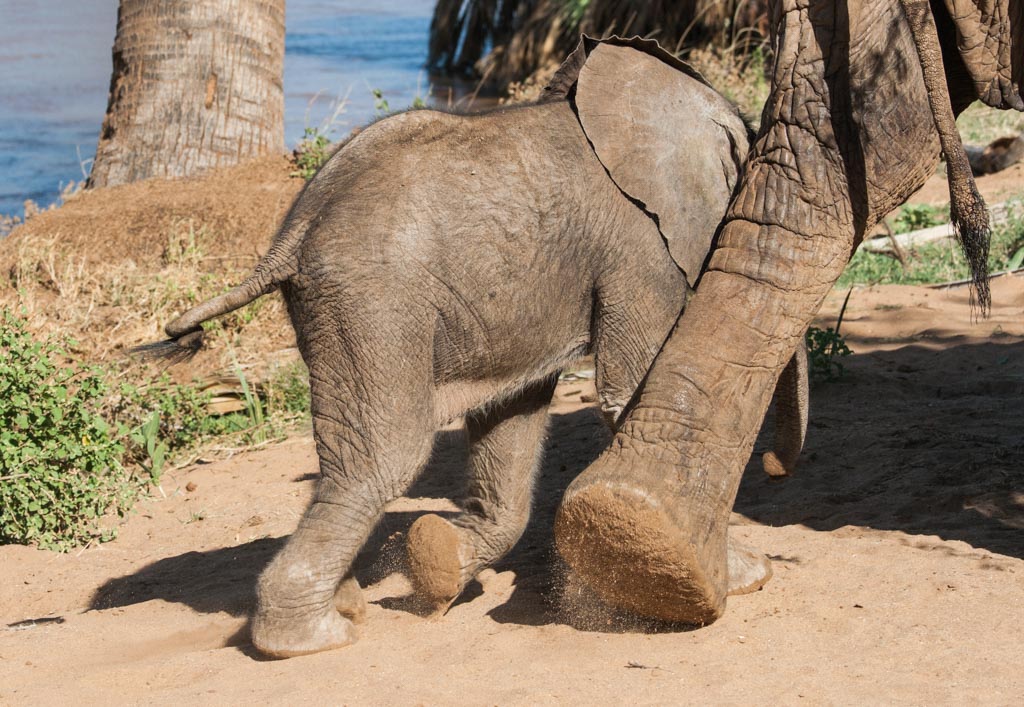
Walking With Elephants
Morula was born around 1977 and was an orphan of a Zimbabwean culling program. She was 31 when I met her and had the opportunity to walk with her through the wilds of the Okavango Delta. She was one of three elephants that I was privileged to spend time with, accompanied by Doug Groves of the Living with Elephants Foundation. Rubbing her trunk, legs, and belly, my fingers roamed her textures, delighting in the feel of her hard, rough skin and her prickly, thick ridges covered with short bristles of hair. We joined her family, trailing behind and walking through the bush, in her way, in her time. When she lay her trunk over my shoulder it felt like a wire brush and I was astonished by its weight. My heart danced in my chest...

Elephant Ears are a Soft Touch
There is absolutely nothing delicate about the texture of elephants. That is until you rub behind their ears. The most heightened sensory experience I have ever had with an animal has been running my hands behind the ears of an elephant. Their skin transforms. Warm and soft with smooth contours, those enormous flaps protecting hidden hollows. It is magical. They are living landscapes my palms have roamed in wonder.
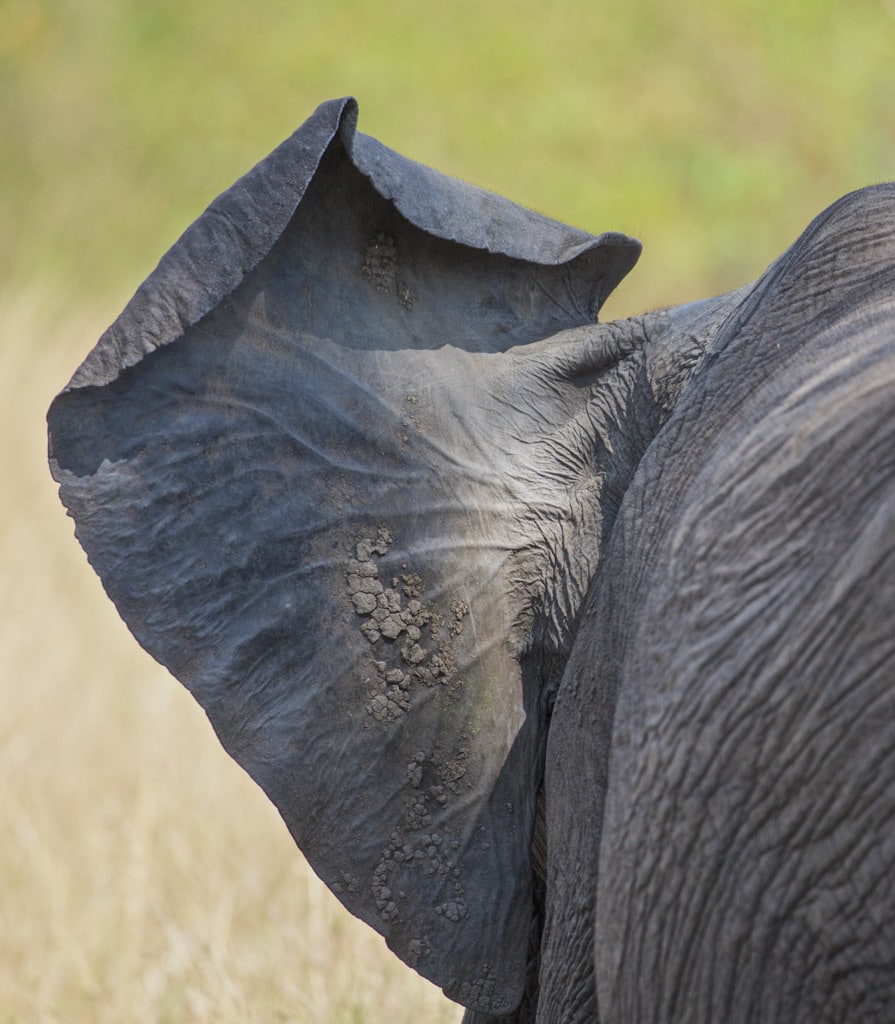
Our Connection to Elephants
Elephants seem to hold enormous appeal. I am not quite sure what it is about this marvelous animal that captivates us so. Whether it is the unimaginable size or that wondrous and unusual body? Or perhaps we are drawn to the herd and the close sense of family they share with humans? Or maybe their deeply emotional personalities? Whatever it is, of one thing I am quite certain; our connection to the elephant runs very, very deep.
I know I have been charmed by the elephants I have met and I am fortunate to carry them with me.
View Elephant Gallery Check out NJ Wight's Art Cards!
For more information about elephants and how you can help, please visit the following organizations:
http://www.sheldrickwildlifetrust.org/
http://worldwildlife.org/species/african-elephant
http://www.bornfree.org.uk/campaigns/elephants/
Lion Mating: She's the Boss
Life is not always easy for the King. When a lion receives his mating call to duty, he is required to muster up all the stamina he has to satisfy his lioness. Given a lion pride may have several females, his work is cut out for him. When a lioness is in heat and looking to mate, she calls all the shots. Much as it is with other big cats, she decides when, where and how often mating will take place. His job is to...well, get the job done.
Lion Mating
Female lions will start mating at about 4 years of age, while males begin closer to 5. Breeding is not seasonal with lions but the females in a pride will often be synchronized in estrus. Much like her feline cousins, a lioness coming into heat will advertise her readiness with sent marking, calling, rubbing on objects and rolling around on the ground. She will engage in a lot of display and she will also be defensive and scrappy.
"She rubs against the male, presenting her posterior with tail raised invitingly, but when he makes a bold approach, she turns upon him spitting, scratching and yowling. The next moment she writhes on the ground at his feet or invites pursuit." –Richard Estes, Author, The Behaviour Guide to African Mammals
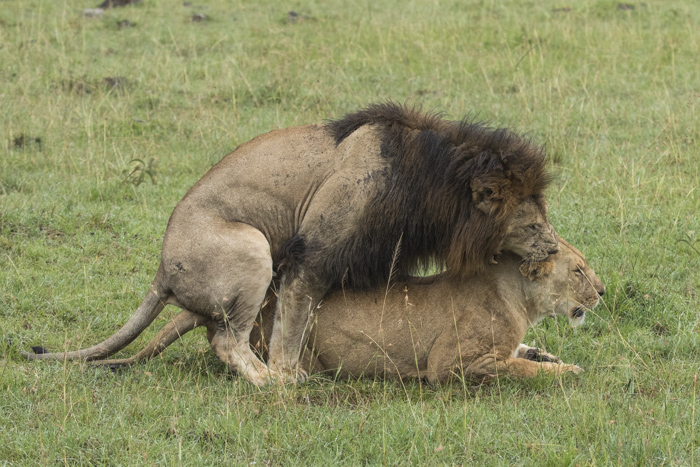
The Big Finish
Male courtship behaviour usually entails lots of head rubbing with the female, urine spraying, licking his genitals and patiently following her. When the lioness is ready and presents, the male will try to grip her neck before mounting. Once he mounts, copulation is generally completed with a few thrusts.
"Immediately afterward, the female screams, or snarls, and often twists and hists out at the male, who jumps back growling." Within a few minutes courtship is resumed." The Behaviour Guide to African Mammals, Richard Estes
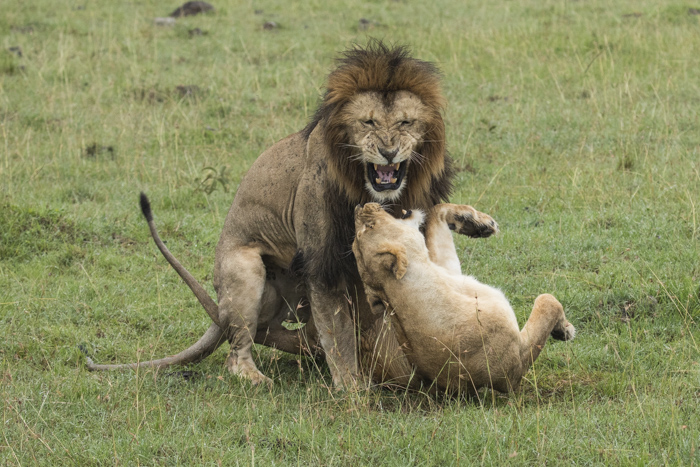

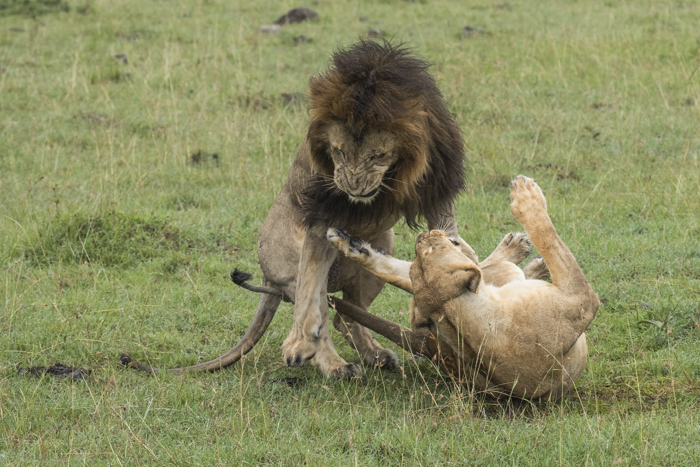
Gestation is 14–15 weeks and the typical litter is between 1–4 cubs. She will find a well-hidden, bushy area to have her cubs and will keep them sequestered from the pride for over a month, moving them often to keep them safe. When she eventually rejoins the pride, she will share the mothering duties, nursing her own cubs and those from other lionesses in her pride.
For more lion photos, check out my lion photo gallery.
View Lion GalleryJackson's Chameleon: Love at First Sight
When I travel to Africa and meet my guides for the first time, one of the first questions they ask is, What are you hoping to see? Expecting to hear leopard, rhino or elephant, I always enjoy the startled expression that briefly lights up their face when I reply; A chameleon. I love chameleons and photographing them is very high on my wish list when I go on safari. I have had some very lucky encounters with South Africa's flapneck chameleon, the old-world lizard that first seduced me and ignited my passion. But in November of 2014 I was fortunate to meet Anton Child, proprietor of The Emakoko, a fabulous lodge in Nairobi National Park. Anton's enthusiasm for snakes and reptiles was infectious and he quickly introduced me to to a little three-horned wonder: the Jackson's chameleon. I must admit, I fell hard. I soon realized I would become a loose and easy woman when it came to loving little green reptiles.
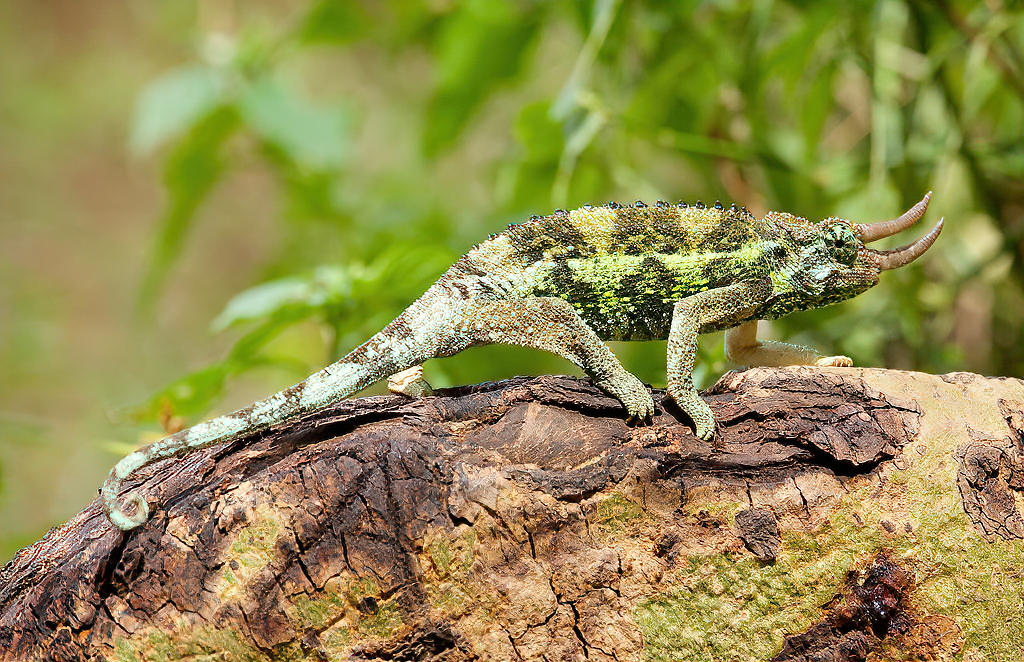
Trioceros jacksonii
Trioceros jacksonii, the three horned chameleon gets its name from trioceros, a Greek derivative from the combined terms tri which means three, and keras meaning horns. These little lions are known for their fierce defensive displays where they can be seen hissing and lunging at their opponent, as well as doing battle with their unique and formidable horns. These unique looking lizards with their little mitten-like hands have wonderous eyes shaped like a dotted turret with a glassy pupil. The males have three horns protruding from their crest and their long and speedy tongues, extending 1.5 times their body length, can fully extend in .07 seconds.
Jackson's chameleon Socializing
Jackson's are solitary lizards and outside of their mating season will stick to themselves, intimidating each other if territories are compromised. But when the days get hotter and longer and it is time to find a mate, males will begin a series of displays to initiate courtship with a lady-Jackson's. As they sway and dance, lifting their spiny backs higher, they might stretch up their neck and open their mouth wide, displaying their powerful jaws hoping to convince her of their hunting prowess. They will also rapidly change colour creating a vibrant display meant to win her heart. And if a female happens to have eyes for two males, it will come down to a joust with horns to determine who will move on to the next round.

The native home of this intriguing reptile is Mount Kenya, with its varied vegetation and high insect population. At some point, humans transported the Jackson's chameleon to Hawaii, where they have now made a home, thriving amongst the rich vegetation and plentiful insect population. Sadly, chameleons of all varietals are a very popular exotic pet and far too many of these creatures are now captured in the wild and then shipped around the world for private ownership, many dying along the way.
Photographic Challenges
Chameleons certainly charm the camera, but they are a challenge to capture. First, you have to find them. They are very well camouflaged. I rely on Anton on our travels around Nairobi where even the vegetation in a parking lot can provide a hidden home. In the dark shadows of foliage, you do not have much light and the small horns are long enough to throw off your depth of field. Trying to steady yourself as you reach in between branches and relying on very low f-stops and slow shutter speeds to compensate for the lack of light, they are difficult to capture from end-to-end — but I certainly never tire of trying!
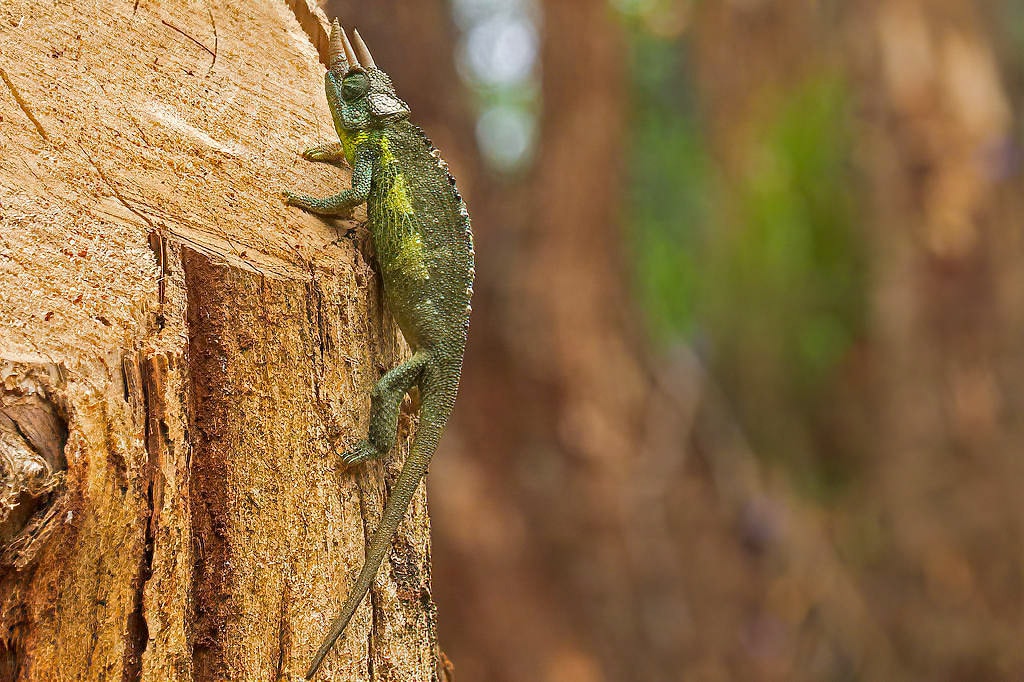
For more about my adventures with chameleons, check out Up Close with Chameleons on my ko-fi.com/njwight page.
Battle of Life and Death in South Luangwa
On an evening game drive in the Nsefu sector of South Luangwa National Park, we came across a very unusual and emotional sighting. Down on the dry riverbed, a battle of life and death was taking place between an animal at the very beginning of its life, and one nearing the very end. This story was published with editorial copy and colour images in the U.K.'s Daily Mail. The story below is my own.
(The images that follow contain difficult subject matter.)
A Lioness Nearing Her End
Midmorning we spotted an older lioness lying lifeless in tire tracks on the Luangwa riverbed. The sun was blazing hot and she most certainly had no energy to move. From her sharp hip bone and protruding ribcage, it was quite clear she was suffering and had not eaten for many days. Because she was at a distance, it was difficult to see her well, but her distress was painfully evident. As we drove away, I honestly did not think this girl would make it through the day. The fact that she was a mature female, ant least 12 years old — near the end of her natural life — did not make it any less heartbreaking. It is one of the hardest things about what I do — watching an animal suffering and knowing all you can do is respectfully bear witness.
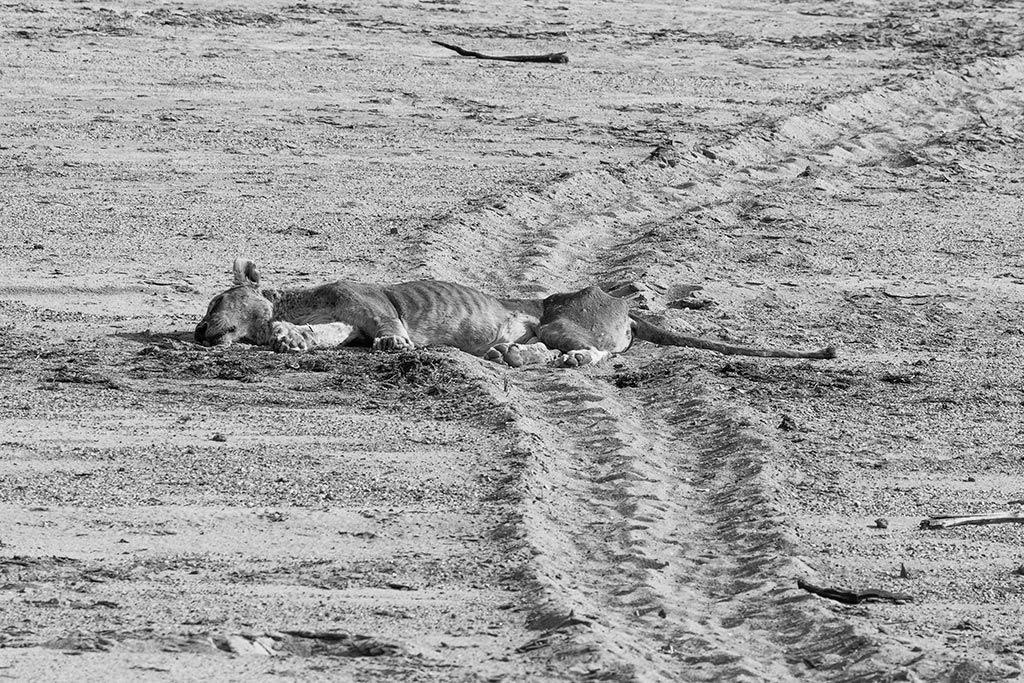
Later that day, driving through the shadows of nightfall, we were alerted to activity down on the river bed. We arrived under darkness and positioned ourselves on the bank above. In the middle of the riverbed we were shocked to see the same lioness and she was in the throes of attacking a young elephant! They were at a fair distance and it certainly proved challenging to photograph under the fading beams of the jeep headlights.
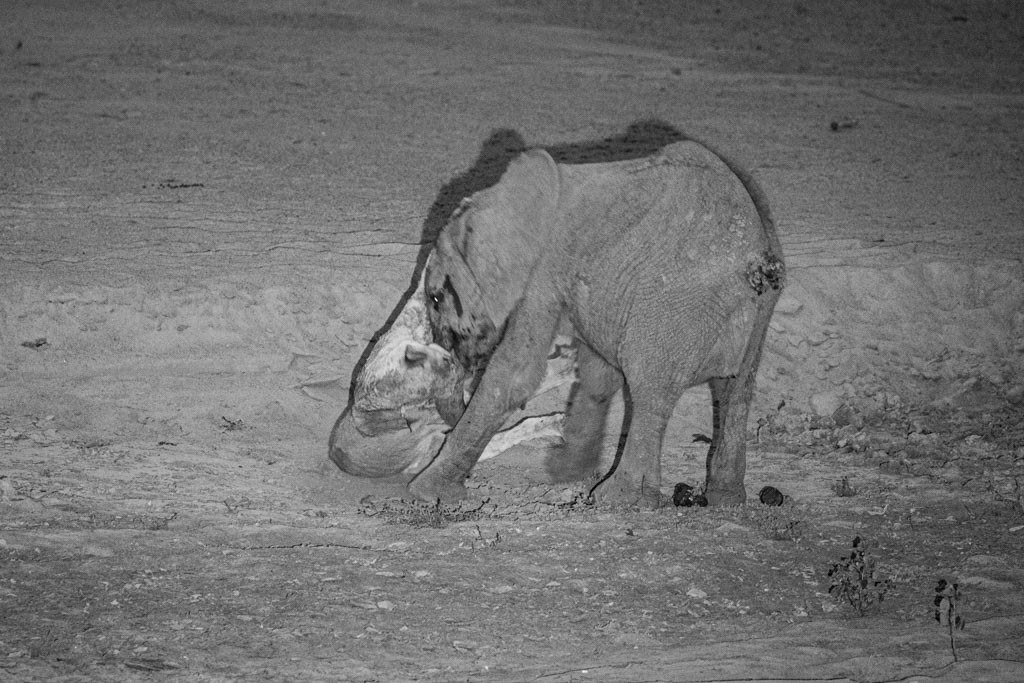
A Young Elephant Fends for Itself
The elephant was likely between 1-2 years old and far too young to be on its own. Clearly separated from its herd, it would have a difficult time surviving. That did not stop the calf from putting up a heroic fight. By the time we arrived, it was evident that the lioness had already bitten off the elephant’s tail. She had the small trunk in her jaws, wrestling to hold on and bring it down. It was shocking to see such a young elephant all alone in this fight for life. However, it was equally painful to watch the desperation of this very weak lioness. She was clearly struggling to find the strength to hunt and live one more day.
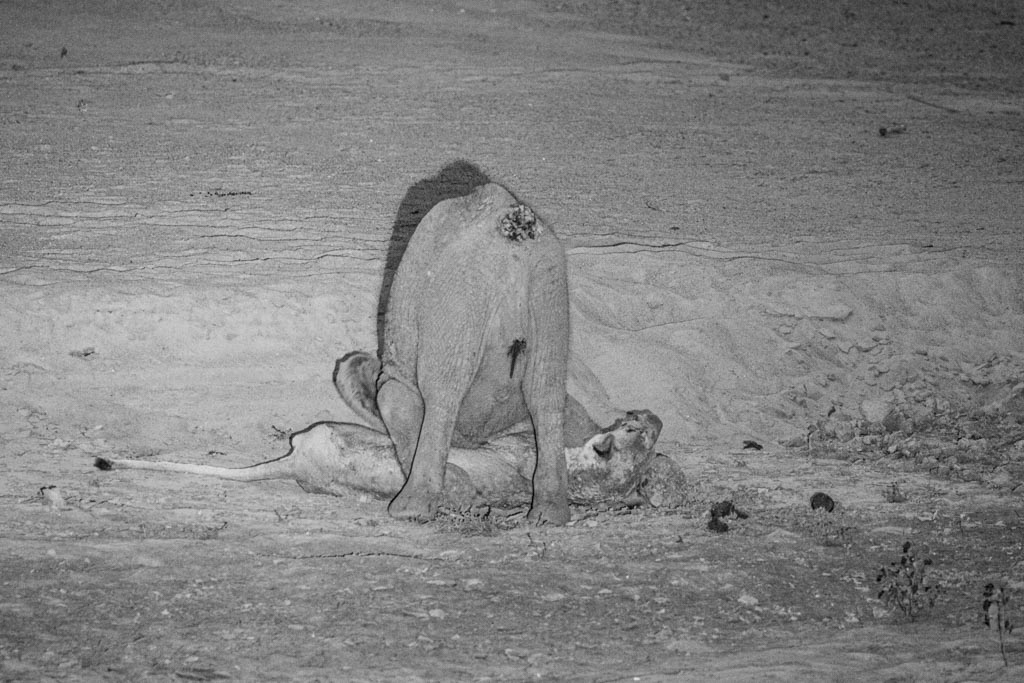
The tenacious young elephant managed to use its bulk to its advantage, straddling the lioness as she was clinging to its trunk. The big cat was eventually too weak to hold on and found herself flattened. She was in a desperate situation under the weight of her feisty opponent.

A Battle of Life and Death Comes to an End
It took an enormous effort for the old lioness to pull herself free. When she finally managed to stand, the young elephant turned towards her, fiercely trumpeted and fearlessly chased her off!
 Moments later, the emaciated big cat climbed the bank and came out right in front of our truck. She was panting heavily and clearly exhausted. We could see she had several teeth missing and her gums were bleeding.
Moments later, the emaciated big cat climbed the bank and came out right in front of our truck. She was panting heavily and clearly exhausted. We could see she had several teeth missing and her gums were bleeding.

No Winner in South Luangwa
My heart was heavy for these two fierce survivors. We had likely witnessed the lioness in her last attempt to feed herself. Her body was discovered the next morning. The elephant survived, although was clearly wounded. It was unclear how it came to be wandering on its own at such a young age and I knew in my heart it was going to have more life-threatening challenges ahead if it was not soon reunited with the herd.
On Life and Death and Bearing Witness
It is never easy to see an animal suffer, but for one animal to survive, often, another must die. This is a fundamental part of understanding our natural world. It is a fundamental part of my work to document these difficult but natural occurrences.
Professionally, it is my intention to teach about the wildlife subjects I observe and photograph—all aspects of their lives. When I am working, I try not to turn my back on an animal suffering because it is uncomfortable for me. I very much try to hold myself accountable to bear witness. I show my respect to a life that is being taken by not turning away, and I say a silent thank you to them for giving their life so that another can live. I watch a predator hunt successfully and I feel gratitude that they are able to have another meal-especially if they have a family. This part of my work Is never easy, but I am committed to doing my best to hold both of these feelings in my heart at the same time. To honour both lives. I have learned more than I could have ever imagined by watching difficult sightings in the wild. It has been a great privilege to bear witness to all I have seen.
Thanks!
I appreciate you taking the time to look at my work. I support myself through my photography and writing. Please check out my memberships on Ko‑fi My members have access to additional exclusive content, including behind-the-scenes virtual safari updates. I greatly appreciate your support. Thanks for your consideration.
New Beginnings
"If all you can do is crawl, start crawling." —Rumi
What better way to bring in a new year than to celebrate some of the little lives I have been privileged to photograph in Africa. It is always special to watch young animals making their way in the world with exuberance and curioisty and I love the creative challenge of capturing their energy and innocence. They are endlessly amusing and I am aware of striking a balance between following their antics through the viewfinder and sitting back and enjoying the show. Either way, it is difficult not to feel joyful in their presence. They are so deserving of our respect and protection. We must not fail them.


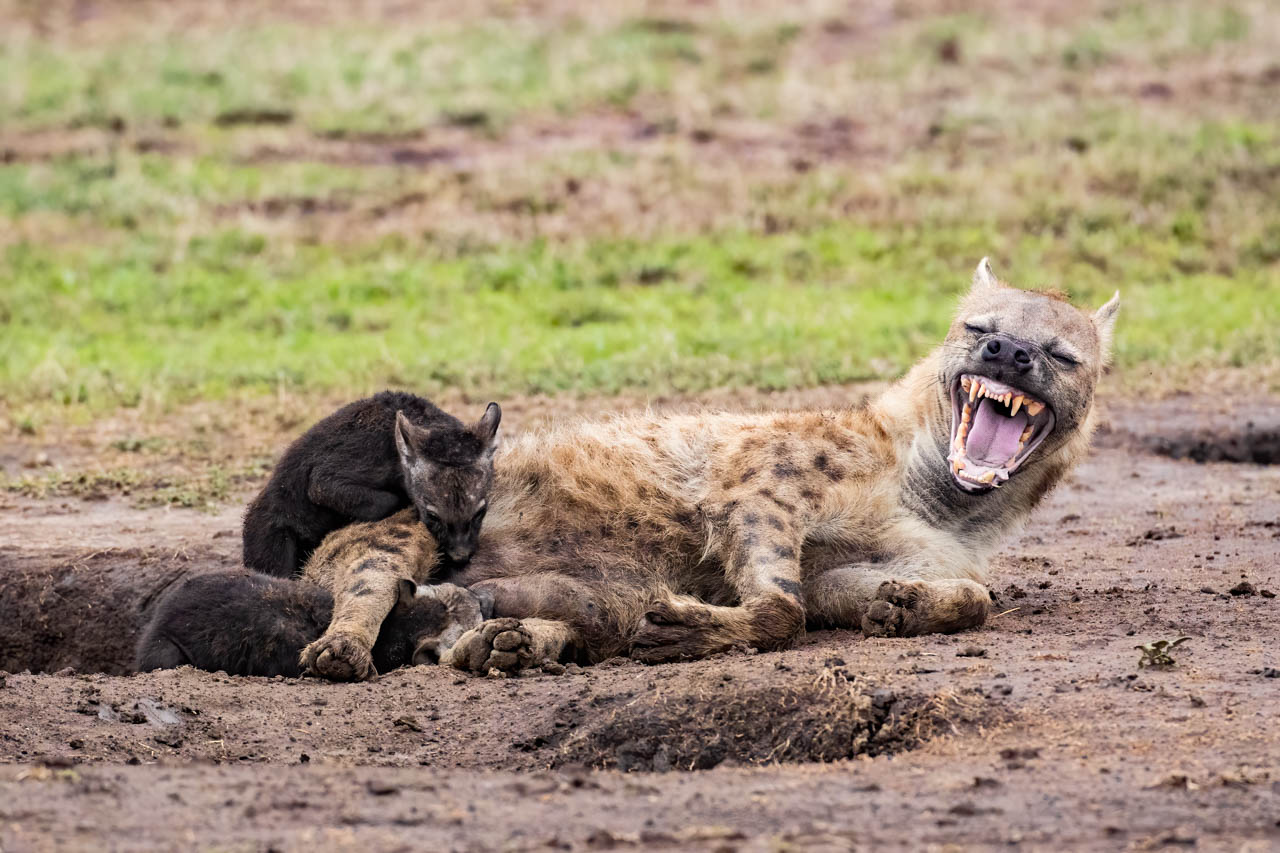

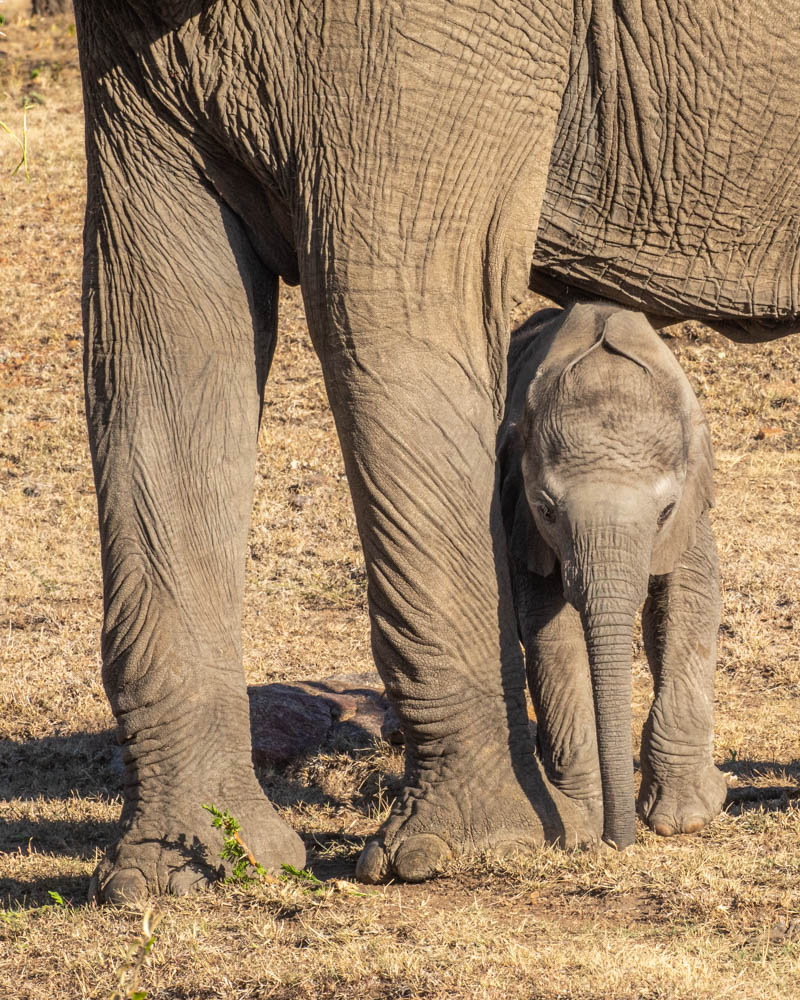
Wishing you a peaceful year. Thanks so much for your continued encouragement and support of my work.



